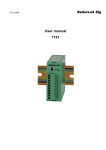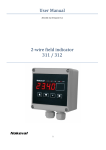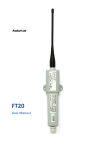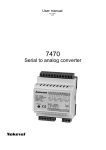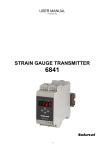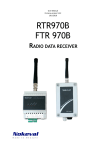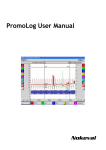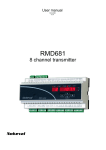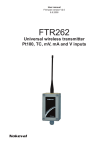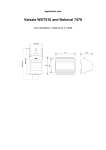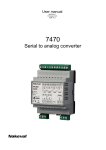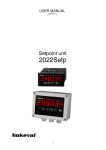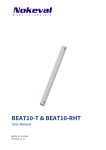Download FTR860 manual.indd
Transcript
User manual Firmware version V1.0 10.4.2007 FTR860 2 channel wireless transmitter with temperature sensor, mV, mA and digital inputs Nokeval FTR860 User Manual INTRODUCTION FTR860 is a two channel transmitter for temperature sensor, mV and mA inputs housed in a field enclosure. Measured values are transmitted using license free 433.92 MHz frequency band (ISM) so it can be freely used, for example, almost in whole Europe. The transmitter has a whip antenna for radio coverage up to 200 meters in free space. The transmission interval is programmable and can be set from four seconds to over four minutes. FTR860 has also two digital inputs (0-5 VDC or 0-230 VAC). The device supports both 24 VDC and 230 VAC supply voltages. Contents Introduction ................................................................................................................................. Installing ..................................................................................................................................... Supply voltage ............................................................................................................................ Settings ...................................................................................................................................... Inputs .......................................................................................................................................... Radio transmitter ........................................................................................................................ Indicator lights ............................................................................................................................ Specifications ............................................................................................................................. Manufacturer Tel: +358 3 3424800 Fax: +358 3 3422066 Web: www.nokeval.com Technical support: [email protected] Nokeval Oy Yrittäjäkatu 12 FI-37100 Nokia Finland 2 2 3 4 5 6 10 12 13 FTR860 User Manual INSTALLING Connections For more detailed information about connections see chapters Supply Voltage and Inputs. 3PIN POL programming connector Antenna 1 2 3 4 RTD 1 2 1 2 3 4 1 2 3 4 Input 1 Input 2 34 RTD mV/TC 3 4 + com/- Digital Inputs mA 3 4 DI1 DI2 1 2 3 4 + - 4...230 VDC/VAC Both channels can be configured to any supported input 1 2 3 4 Power 1 2 3 4 20...250 VDC 24...250 VAC Connecting the antenna The antenna is connected to the BNC connector at the top side of the case. The antenna can be either directly connected to the BNC connector of the device or alternatively a 50 ohm coaxial cable (RG-58) with BNC connectors can be used to connect the antenna to the device. First align the female connector’s two guideposts to the male connector’s channels. Then press the BNC connector in and lock the connector by rotating the male connector’s outer ring clockwise. If needed, the antenna can be removed by rotating the ring counter clockwise and then pulling out the antenna. 3 FTR860 User Manual SUPPLY VOLTAGE The device has an universal power supply that supports following voltage ranges: • 20...250 VDC • 24...250 VAC Device’s current consumption is less than 40 mA. 1 2 3 4 Power 1 2 3 4 Connect the supply voltage to terminals 1 and 3. Either polarity will do. The connector housing provided with the device must be used when connecting the supply voltage. Attention! The device contains high voltages also when 24 V supply voltage is used. These parts are protected using separate plastic casing that contains no user serviceable parts. Do not open this protective casing. 4 FTR860 User Manual SETTINGS Connection settings Use Mekuwin program or Nokeval 6790 hand held programmer to configure the device. You can download Mekuwin from Nokeval’s web site for free. Communication settings for configuration: Baud rate 9600 protocol SCL address 0 Programming connector Programming connector The device can be programmed using a PC or Nokeval 6790 hand held programmer. The device has a 3PIN POL programming connector. Use POL-3PIN adaptor to connect a POL-RS232 cable, DCS772 (USB-POL converter) or 6790 to the device. When the programming connector is connected the device sends measurement data about every 1.3 second. This feature is ment only for testing purposes. When the configuration connection is open no measurement data is sent. Menu tree FTR860 menu structure. Both input channels have similar submenus. Conf Inputs Output Inputs In1 In2 Output Period [s] Gate1 Gate2 In1 Sensor Wires R0 Pts Mea1 Sca1 Mea2 Sca2 5 FTR860 User Manual INPUTS Settings The configuration menu is divided in several submenus. The input settings are in a submenu called Inputs, which is further divided in In1 and In2 submenus. In1 and In2 submenus are identical. Input submenu Inputs Sensor (In1, In2) Input range and sensor selection. • Off: • Pt, Ni, Cu: • Ohm: • mV: • TcB…TcT: • mA: In1 In2 Channel is not in use. Resistance thermometers (RTD’s). The nominal resistance is set in R0 (see below). The reading is in Celsius. See also sections Wires and R0. Resistance inputs. The resistor is connected in three-wire or four-wire connection. The reading is in ohms. See also section Wires. Voltage input -30...2000 mV. The reading is in millivolts. Thermocouples. The reading is in Celsius. Current input 0..25 mA. The reading is in milliamperes The appropriate jumper inside the case has to be closed. In1 Sensor Wires R0 Pts Mea1 Sca1 Mea2 Sca2 Wires (In1, In2) RTD connection method. Only visible when RTD or Ohm input is selected. • 2: • 3: • 4: two-wire connection three-wire connection four-wire connection R0 (In1, In2) The nominal resistance of a RTD. With Pt and Ni sensors, this is the resistance at 0 °C. With Pt100 set R0=100. With Cu the nominal resistance is given at 25°C. This setting is not visible on other than RTD inputs. If the real resistance of the sensor at the nominal temperature is known, it can be fed here, in order to cancel the sensor error. Pts (In1, In2) Number of scaling points. The scaling means converting the reading to represent some other (engineering) reading. • 0: • 1: • 2: No scaling. The reading equals measured reading. One point offset correction. The reading corresponding to Mea1 is scaled to be Sca1 when displayed, using appropriate offset value. Two point scaling. Readings from Mea1 to Mea2 are scaled to be Sca1 to Sca2. Any values can be used, these have not to be the end points. 6 FTR860 User Manual Mea1, Sca1, Mea2 and Sca2 (In1, In2) Scaling points. Visibility of these settings depends on the Pts setting. Unscaled reading Mea1 is converted to Sca1, and Mea2 to Sca2. Example: Pressure transmitter sends 4-20 mA for pressures 0-6 bar. Pts = 2 Mea1 = 4 (mA) Sca1 = 0 (bar) Mea2 = 20 (mA) Sca2 = 6 (bar) These scaling points can be conveniently used to calibrate a sensor-transmitter pair in a thermal bath. First set the scaling off by setting Pts=0. Apply one or two known temperatures to the sensor and write down the displayed and the real temperatures. Then set Pts to 1 or 2 depending on the number of calibration points, and write the first reading in Mea1 and the real temperature in Sca1. And the same with Mea2 and Sca2 if two points are to be calibrated. Connections Analog input signals are connected to connectors Input 1 and Input 2. RTD and resistance inputs (ohm, Pt100, etc) two-wire connection If the sensor has two wires, connect them to terminals 2 and 4. 1 2 3 4 RTD three-wire connection If the sensor has two wires the same color, connect these wires in terminals 3 and 4, and the third wire in terminal 2. 1 2 3 4 RTD four-wire connection Four-wire connection: Connect the other end of the sensor in terminals 1 and 2, and the other in terminals 3 and 4. 1 2 3 RTD 7 4 FTR860 User Manual Thermocouple inputs Connect the positive wire (K type: green or brown) of the thermocouple to terminal 3 and the negative (white or blue) to terminal 4. 1 2 3 + 4 Tc Voltage inputs Connect the positive wire to terminal 3 and the negative wire to terminal 4. 1 2 3 + 4 mV Current inputs Connect the positive wire to terminal 3 and the negative wire to terminal 4. 1 2 3 + 4 mA Close the channel’s mA jumper. Open Closed mA jumpers 8 FTR860 User Manual Digital inputs The digital inputs of this device are designed for slow signals and wide voltage range. The measurement cycle is approximately 1.3 seconds. Connect the digital input 1 to terminals 1 and 2. Respectively digital input 2 is connected to terminals 3 and 4. Either polarity will do. The connector housing provided with the device must be used when connecting the digital inputs. 1 2 3 DI1 4 DI2 Both direct and alternating voltages can be connected to digital inputs. For example: 0 / +5 VDC 0 / +24 VDC 0 / 230 VAC Input state is interpret as ”off” if the voltage between the terminals is less than 2 volts and ”on” if the voltage is over 4 volts. Maximum allowed voltage difference between the terminals is 330 VDC or 230 VAC. The insulation between the digital inputs does not fulfill the requirements set for double insulation or reinforced insulation. Therefore, no dangerous voltages can be applied to the other digital input if the other is in contact with a user accessible part. Digital inputs can also be used as a threshold condition to sending measurement data using radio. For more information about this in the chapter Radio transmitter. 9 FTR860 User Manual RADIO TRANSMITTER The device sends both the measurement data from both input channels using license free 433.92 MHz frequency range. If needed, radio transmission of a channel can be disabled by setting channel’s sensor type to ”Off”. Settings Output Output submenu Period Period Interval between consecutive radio transmissions. The valid range for the parameter is 4...254 seconds. Gate1 Gate2 There is a small random variation in the transmission interval (max 5.3 % from the defined value). The purpose of this variation is to prevent continuous collisions of data packets send by different devices. The maximum number of radio transmitters in a coverage area is limited by radio standards. The use of repeaters reduces the maximum number of transmitters because repeaters use the same frequency channel as transmitters. The following example table shows the allowed maximum number of FTR860 transmitters in a coverage area. 2 channels Transmission Interval (s) 5 10 20 30 40 50 60 90 120 240 Receiver and Receiver and 1 repeater 2 repeaters Maximum number of transmitters 10 5 3 20 10 7 39 20* 13 59 29 20 78 39 26 98 49 33 118 59 39 176 88 59 235 118 78 471 235 157 Receiver 10 FTR860 User Manual 1 channel Transmission Interval (s) 5 10 20 30 40 50 60 90 120 240 Receiver and Receiver and 1 repeater 2 repeaters Maximum number of transmitters 26 13 9 53 26 18 105 53** 35 158 79 53 211 105 70 263 132 88 316 158 105 474 237 158 632 316 211 1263 632 421 Receiver For example, if you have transmission interval of 20 seconds and one repeater, the maximum number of transmitters is 20*. When only one channel is in use, the maximum number of transmitters is 53**. Gate1 If enabled, the measurement data of input channel 1 is not transmitted unless the state of the digital input 1 is ”On”. When the state of the digital input 1 changes from ”Off” to ”On” the next finished measurement result is immediately sent. The next measurement result is sent after the defined transmission interval if the state of the digital input 1 is still ”On”. Gate2 If enabled, the measurement data of input channel 2 is not transmitted unless the state of the digital input 2 is ”On”. When the state of the digital input 2 changes from ”Off” to ”On” the next finished measurement result is immediately sent. The next measurement result is sent after the defined transmission interval if the state of the digital input 2 is still ”On”. 11 FTR860 User Manual INDICATOR LIGHTS The device has five indicator lights that show the current state of the system, digital inputs, radio transmission and power. In normal operation these lights are not normally needed but they are very useful when troubleshooting error conditions. OK DI1 DI2 RF Power OK When the system is operating normally this indicator light blinks constantly. If the indicator light doesn’t blink reset the device by disconnecting power from the device for a moment. If this doesn’t help the device must be sent for service. DI1 This indicator lights when the state of the digital input 1 is ”On”. DI2 This indicator lights when the state of the digital input 2 is ”On”. RF This indicator light flashes every time a measurement data is sent. Power This indicator is always lit when power is applied to the device. 12 FTR860 User Manual SPECIFICATIONS Radio transmitter Input Pt100 Range Accuracy Thermal drift -200...700 °C 0.05% rdg + 0.25 °C 0.02 °C/°C Ni100 Range Accuracy Thermal drift -60...180 °C 0.05% rdg + 0.25 °C 0.02 °C/°C Cu10 Range Accuracy Thermal drift -200...260 °C 0.05% rdg + 0.25 °C 0.02 °C/°C Thermocouples TC B C D E G J K L N R S T Thermal drift Accuracy range lin.error 400…1700°C ±0.3°C 0…2300°C ±0.5 0…2300°C ±1 -100…900°C ±0.2 1000…2300°C ±2 -160…950°C ±1 -150…1370°C ±0.5 -150…900°C ±0.5 0…1300°C ±0.1 0…1700°C ±0.5 0…1700°C ±0.5 -200…400°C ±1 0.02°C / °C (ref 25°C) 0.05% rdg + 0.5°C + lin.error + thermal drift mV Range Accuracy Thermal drift -30...2000 mV 0.05% rdg + 0.01 mV 50 ppm/°C mA Range Accuracy Thermal drift 0...25 mA 0.008 mA 50 ppm/°C Antenna Connector: 50 ohm female BNC connector Standard antenna: Quarter-wave whip antenna (BNC connector) Frequency range: License free 433.92 MHz subband f according to ERC/REC/70-03 Power supply Voltage: 24 VDC/230 VAC ±15% Current consumption: max 40 mA Environment Operating temperature: -30...+60 °C Protection class: IP65 Configuration Connector: Protocol: Configuration: 3PIN POL programming connector Nokeval SCL protocol PC with Mekuwin for Windows 98...XP or 6970 hand held programmer Regulations EMC directive • EMC immunity EN 61326 • EMC emissions EN 61326, class B R&TTE directive • EN 300 220 class 3, Transmitter power class 8 (10 mW) • EN 301 489 • EN 300 339 Measures Case 180 mm x 130 mm x 60 mm (WxHxD) Antenna 178 mm, Ø 8...16 mm 13 FTR860 User Manual 14














